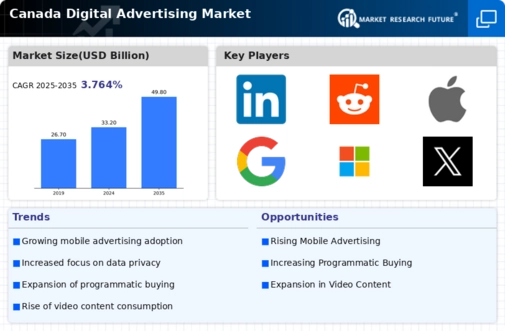The digital advertising market is characterized by a dynamic competitive landscape, driven by rapid technological advancements and evolving consumer behaviors. Major players such as Google (US), Meta (US), and Amazon (US) are at the forefront, leveraging their extensive data analytics capabilities to enhance targeted advertising. Google (US) focuses on integrating artificial intelligence (AI) into its advertising solutions, thereby improving ad relevance and effectiveness. Meta (US), on the other hand, emphasizes community engagement and user-generated content, which appears to resonate well with younger demographics. Amazon (US) continues to expand its advertising services, capitalizing on its vast e-commerce ecosystem to offer unique advertising opportunities that blend shopping and advertising seamlessly. Collectively, these strategies not only intensify competition but also foster innovation within the market.
In terms of business tactics, companies are increasingly localizing their advertising strategies to cater to Canadian consumers' preferences. This localization often involves tailoring content and messaging to reflect cultural nuances, which can enhance engagement rates. The market structure is moderately fragmented, with a mix of established giants and emerging players. The collective influence of key players like Google (US) and Meta (US) shapes the competitive dynamics, as they set benchmarks for advertising effectiveness and technological integration.
In October 2025, Google (US) announced a new initiative aimed at enhancing privacy controls for advertisers, which is expected to reshape how data is utilized in digital advertising. This move is strategically significant as it aligns with growing consumer concerns regarding data privacy, potentially positioning Google (US) as a leader in responsible advertising practices. By prioritizing user privacy, Google (US) may not only retain existing advertisers but also attract new clients who value ethical advertising.
In September 2025, Meta (US) launched a new suite of tools designed to facilitate small business advertising on its platforms. This initiative is crucial as it empowers smaller enterprises to leverage digital advertising, thereby expanding Meta's user base and increasing ad revenue. By focusing on small businesses, Meta (US) appears to be diversifying its revenue streams while fostering community engagement, which could enhance brand loyalty.
In August 2025, Amazon (US) unveiled a new advertising format that integrates video content into its product listings. This strategic move is likely to enhance user experience and drive higher conversion rates, as video content has been shown to increase consumer engagement. By innovating its advertising formats, Amazon (US) not only strengthens its position in the market but also sets a precedent for how e-commerce and advertising can converge.
As of November 2025, current trends in the digital advertising market include a pronounced shift towards digitalization, sustainability, and AI integration. Strategic alliances among key players are increasingly shaping the competitive landscape, as companies collaborate to enhance technological capabilities and expand market reach. Looking ahead, competitive differentiation is expected to evolve, with a greater emphasis on innovation and technology rather than price-based competition. Companies that can reliably integrate advanced technologies into their advertising solutions are likely to gain a competitive edge, thereby redefining the parameters of success in this rapidly changing market.


















Leave a Comment